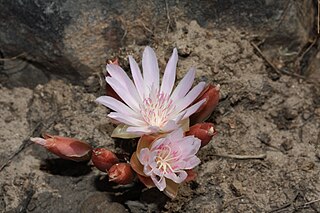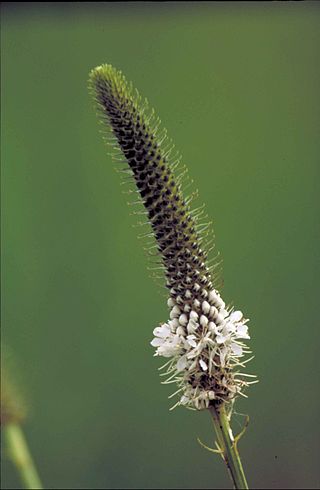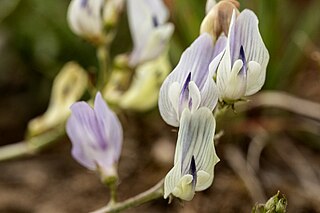
Bitterroot is a small perennial herb in the family Montiaceae. Its specific epithet rediviva refers to its ability to regenerate from dry and seemingly dead roots.

Camassia is a genus of plants in the asparagus family native to North America. Common names include camas, quamash, Indian hyacinth, camash, and wild hyacinth.

Eriophyllum lanatum, with the common names common woolly sunflower, Oregon sunshine and golden yarrow, is a common, widespread, North American plant in the family Asteraceae.

Toxicoscordion venenosum, with the common names death camas and meadow death camas, is a species of flowering plant in the genus Toxicoscordion, of the Melanthiaceae family. It is named for its well known toxic qualities with its common names and scientific name referencing this. Because its nectar is also poionous, it is mainly pollinated by the death camas miner bee, which specializes collecting the toxic pollen for its young. It is native to western North America from New Mexico to Saskatchewan and west to the Pacific Ocean.

Physocarpus, commonly called ninebark, is a genus of flowering plants in the family Rosaceae, native to North America and northeastern Asia.

Hackelia (stickseeds) is a genus of plants in the borage family, Boraginaceae. It includes 54 species found in North America, western South America, temperate Eurasia, and Australia. 12 species are native to California.

Heterotheca is a genus of North American plants in the family Asteraceae.

Dalea is a genus of flowering plants in the legume family, Fabaceae. Members of the genus are commonly known as prairie clover or indigo bush. Its name honors English apothecary Samuel Dale (1659–1739). They are native to the Western hemisphere, where they are distributed from Canada to Argentina. Nearly half of the known species are endemic to Mexico. Two species of Dalea have been considered for rangeland restoration.

Ericameria nauseosa, commonly known as chamisa, rubber rabbitbrush, and gray rabbitbrush, is a shrub in the sunflower family (Aster) found in the arid regions of western North America.

Cirsium cymosum is a North American species of thistle known by the common name peregrine thistle. It is native to the western United States, where it has been found in California, Oregon, Nevada, Utah, Idaho, Wyoming, and Montana.

Lewisia kelloggii is a species of flowering plant in the family Montiaceae known by the common name Kellogg's lewisia. It is endemic to the Sierra Nevada of California, where it is known from several sites high in the mountains. It grows in rocky mountain habitat in granite and slate substrates. This is a perennial herb growing from a thick, short taproot and caudex unit. It produces a basal rosette of many thick, leathery, spoon-shaped leaves up to 9 centimeters long. The inflorescence bears several flowers, each on a very short stalk. The flower has 5 to 13 shiny white or pinkish petals just over a centimeter long. Under the petals are two sepals and two similar bracts lined with spherical resin glands.

Lewisia leeana is a species of flowering plant in the family Montiaceae known by the common name quill-leaf lewisia. It is native to California and Oregon, where it grows in the mountains of the Sierra Nevada and Klamath Ranges. This is a perennial herb growing from narrow, woody taproot connected to one or more caudices. It produces a basal rosette of many fleshy flat to cylindrical blunt-tipped leaves up to 4 centimeters long. The inflorescence bears many flowers on erect, branching stems up to about 24 centimeters tall. Each flower has 5 to 8 white, pink, or purplish petals each about half a centimeter long.

Dieteria canescens is an annual plant or short lived perennial plant in the family Asteraceae, known by the common names hoary tansyaster and hoary-aster.

Sabulina nuttallii is a species of flowering plant in the family Caryophyllaceae known by the common names Nuttall's sandwort and brittle sandwort.

Cirsium eatonii, commonly known as Eaton's thistle or mountaintop thistle, is a North American species of flowering plants in the family Asteraceae.

Brickellia microphylla, the littleleaf brickellbush, is a flowering plant species in the family Asteraceae native to western North America.

Brickellia oblongifolia, the Mojave brickellbush, is North American species of plants in the family Asteraceae. It is widespread across arid and semi-arid regions in the western United States and Canada, from British Columbia south to southern California, Arizona, and New Mexico.

Heterotheca villosa, commonly known as the hairy goldenaster, is a species of flowering plant in the family Asteraceae found in central and western North America.

Astragalus miser, the timber milkvetch, is a species of flowering plant in the family Fabaceae. A perennial, it is native to western North America, except California. One of the locoweeds toxic to livestock, it contains miserotoxin.





















